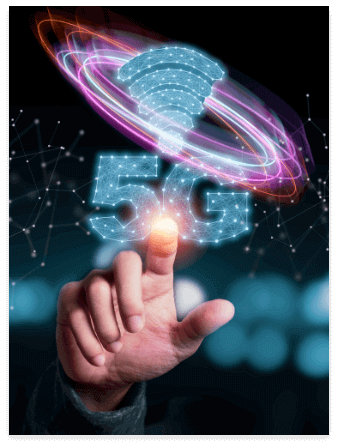As the demand for connection grows, especially with 70% of the U.S. workforce relying on wireless devices, businesses are faced with the challenge of adapting to this digital shift within the next four years. The prevalence of wireless devices is rapidly increasing, and with technologies like Private 5G/LTE, the potential for maximizing their usefulness is unprecedented. Only organizations equipped to leverage these advancements will reap the benefits, leaving others trailing behind.

To ensure your readiness for the impending shift, it is crucial to seamlessly integrate Private 5G/LTE into your existing network. This strategic integration not only ensures that your organization's wireless requirements are met today but also future-proofs them through our cutting-edge enterprise solutions. Embracing a comprehensive approach, supporting a spectrum of networks including Private 5G/LTE, and DAS, is the key to achieving widespread wireless coverage and enhancing business continuity. This positions organizations to thrive in the era of heightened connectivity dependence.
A growing number of forward-thinking CIOs are turning to Black Box for expert guidance in seamlessly incorporating these new technologies into their established wireless networks. This proactive approach positions your organization to harness the full potential of these advancements, meeting the escalating demands placed on wireless networks.
Discover the Power of Private 5G/LTE in Your Environment: Contact us now to schedule a no-obligation test drive and witness firsthand how Private 5G/LTE can elevate the performance of your devices within your unique ecosystem.
With 5G and OnGo™, coupled with other wireless networks, it is important to create a strategy that supports everything wireless—both existing and new.
Black Box can help enterprises implement their wireless strategy
and plan for tomorrow, today by following these principles.
Start by learning the wireless requirements for the devices and applications you use now and plan to use in the future. Design a wireless network to meet those needs. This outside-in approach means that your network will be ready for anything.
With 5G and Private LTE, together with purpose-built wireless networks, you have more leverage now than before. Place the right device and application on the right network to expand your organization’s overall wireless capacity.
When using the two previous principles, you can leverage coverage, capacity, and network selectivity to provide mission-critical performance. Not only on one network, but across all networks.
Mission-critical performance is built into everything we do—from design to deployment to support.
Today’s wireless technologies give organizations many opportunities to streamline their operations and improve the customer experience. Black Box can help you create a complete network that takes full advantage of these advanced technologies with our business WiFi solutions to meet your organization’s unique needs. Come and discover the power of 5G & OnGo.
Use the increased speed of 5G wireless technology to increase your enterprise’s efficiency while reducing costs.
Learn MoreBuild customizable and secure Private LTE wireless networks to increase indoor coverage and capacity. Put OnGo to the test on-site with these demos.
Healthcare Test DrivePublic safety DAS and enhanced, in-building two-way radio services are an absolute necessity for first responders.
Learn MoreUse a real-time locating system to manage assets, optimize workflow efficiencies, and maximize visitor satisfaction.
Learn More
Over the last decade, wireless has become crucial to everything we do. Wireless is not slowing down, but accelerating at an ever-increasing rate. At the heart of wireless technology is 5G and the increased bandwidth for faster connectivity and greater productivity.
Today, 5G technology support nearly 1.3 billion connections. This will more than double to 4.8 billion by the end of 2026. The rapid growth in 5G devices requires organizations to be ready for the new technology or be left behind.
Find out what you need to do now to prepare for 5G in this white paper.
Get the White PaperWhat can 5G and OnGo™ do for your organization? Learn from our 5G and OnGo™ experts how to maximize mobile connectivity.
Navigating the 5G Paradigm Shift: Black Box’s Strategic Expertise for Corporate Readiness
Download FlyerTransforming Manufacturing: Unleashing the Power of Private LTE/5G Networks with Black Box
Download FlyerTelehealth, which played a small role in the healthcare delivery ecosystem before COVID-19, moved to the forefront of healthcare delivery,1, 2 raising its value and importance dramatically. Recent studies documented the sudden, steep rise in
telehealth and its acceptance and demand, as a viable means to safely treat patients during the pandemic crisis, and as we are learning, post-crisis.
Before the pandemic, telehealth was little used and faced several barriers. Top
of the list of obstacles was the patient perception of the poor quality of care. Almost 40%3 of respondents in a telehealth survey were concerned that they would not get proper treatment or a diagnosis with a virtual medical visit. Other
barriers included limited insurance coverage, licensure regulations, and practitioner’s inadequate technological capabilities.4
Most, if not all, of these barriers, fell during the pandemic, and none more dramatically than
the perceived versus actual patient experience. One-quarter of respondents had not even considered telehealth as an option pre-pandemic. However, two-thirds said that because of COVID-19 they are now much more willing to try telehealth services in
the future.5
Telehealth platforms enabled patients to receive healthcare safely, yet effectively. While people may have been reluctant to try telehealth, they are now embracing it in ways that no one could have predicted pre-COVID-19. The numbers are staggering.
For example, a pre-pandemic study projected the telehealth market to grow at an annual CAGR of 14.9% by 2026 with a market value of approximately $53.1 billion by 2026.6
COVID-19 drastically changed the predictions for
telehealth. Frost and Sullivan project a 64.3% increase in demand for telehealth visits and forecast a sevenfold growth in telehealth by 2025 at a CAGR of 38.2%.7
The pandemic panic also kept people from seeking needed
face-to-face medical care. A survey of 36.5 million people by The Journal of the American Medical Association showed that in-person healthcare visits decreased by 37% from March through June 2019 to 2020. But during that same period, virtual medical
visits increased from 0.3% of all contacts in 2019 to 23.6% in 2020. In addition, virtual behavioral health visits also increased from 22.1% to 46.1%.8 In many cases, the switch from in-person to video consultations happened overnight depending on
the existing technological capabilities of the provider.
While many practitioners may have been hesitant to invest in telehealth technology before the pandemic, they jumped on the virtual-care bandwagon. Now 93%9 of healthcare providers offer an online portal, website, or mobile app.
Americans
are finding they like the convenience and effectiveness of telehealth. In one survey, 60% of respondents used telehealth services for the first time during the pandemic and three quarters want to continue using it post pandemic10 for several
reasons, including:
Quality. Americans like the quality of the virtual care they receive; 80% rate telehealth services as equal to or better than in-person healthcare. Of the survey respondents, 56% say telehealth is most effective
for routine checkups while 53% find it most effective for talk therapy and mental health counseling.11
Accessibility. Telehealth is simply easier. In a SatelliteInternet.com survey, more than 25% of telehealth users lived 15 miles,
or more, from the nearest doctor’s office, which can make in-person visits inconvenient, time-consuming, and expensive, especially if patients have a difficult time scheduling due to work or personal responsibilities. In the survey, 54% said
they are more likely to seek medical advice if a telehealth option is available.12
Speed. Simply put, in-person visits can take much longer to schedule, up to two weeks longer according to 46%13 of respondents. And, they take
longer on the actual day of the visit.
Convenience. Patients don’t have to travel, find parking, and sit in waiting rooms. They can simply log in a few minutes before the appointment without leaving home.
Safety. Telehealth provides peace of mind by enabling medical visits without the risk of infecting others or being infected by others.14
Monitoring. Telehealth, via 5G, can directly improve patient care and treatment through
the use of remote monitoring devices. 5G unlocks the speed and high reliability needed to make it possible.
Insurance. Pre-COVID-19, many people did not know if telehealth visits were covered by insurance. Now it is generally not
an issue. At the time of the SatelliteInternet.com survey, 73% said their healthcare program includes a telehealth reimbursement.15
As 5G cellular technology rolls out and becomes more widely available, telehealth connectivity
will increase. 5G promises greater bandwidth and data speeds, low latency, the ability to deliver effective IoT to a massive number of devices. That means eliminating many connectivity problems and enabling faster, cleaner, almost instantaneous data
transmissions. 5G means incredible leaps forward in patient treatment, outcomes, and experiences.
That’s the new reality of 5G and telehealth: happier, healthier, more engaged patients.
5G is on track to become the fastest-adopted mobile communication technology in history. By 2026, it will become the global wireless standard, leaving older 4G networks behind.* Now is the time to create your wireless network of the future. As your partner, we’ll work with you to find the right wireless solution for your organization from one of our best-in-breed partners.
While some integrators can help you with one or two of your wireless networking needs, Black Box can help you with all of them (Wi-Fi, DAS, RTLS, etc.). Our dedicated team of solution architects and deployment engineers will help you make sense of 5G and OnGo™ and understand whether one or both of these new technologies would be a good addition to your existing system. We can then help you develop a comprehensive plan that addresses your current needs while preparing you for the future.
Know More
Leave a commentOrder by
Newest on top Oldest on top